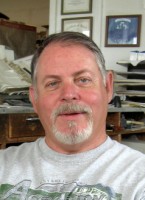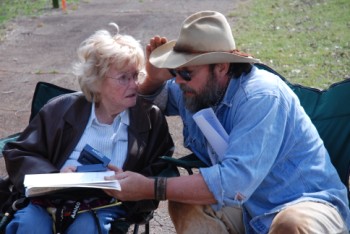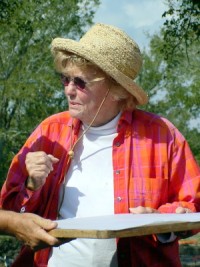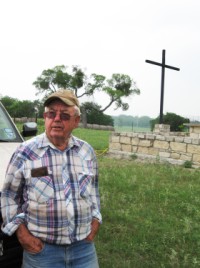Milam County Historical Commission
Milam County, Texas
Milam County, Texas






Getting into the archaeological game
by Jeanne Williams
Temple Daily Telegram - May 11, 2009
SAN GABRIEL - In 1967, Dr. Kathleen Gilmore led the premier archaeological expedition at
the 18th-century Spanish mission San Francisco Xavier de Horcasitas, aided by interns
from Southern Methodist University and an unlikely staff of volunteers - nine members of
the Rockdale High School football team.
Clift Clark, then a 17-year-old Rockdale High School senior, tackled archaeology with
enthusiasm.
Dr. Gilmore “didn’t tolerate much horseplay so we worked,” Clark said. “She was strict.
You didn’t get out there with a shovel and start digging a hole. You used a trowel. She
had an iron fist over us teenage boys and we minded her.” But the boys admired and
respected the SMU professor described by Clark as “very energetic, very smart, and very
focused. She was probably the first woman I met who was like that. She was different.
When she said something, you knew she meant what she said.”
Dr. Gilmore, dressed in jeans, workshirt and hat, labored side by side with the boys,
and “didn’t mind getting her hands dirty,” Clark said.
Carefully following Dr. Gilmore’s instruction, the youths measured off squares and
meticulously scraped away soil with trowels. At 2 feet down they struck gold. Not real
gold, but shards of dinnerware identified by its distinctive patterns as the type made
in Europe during the 1700s.
“We found a lot of old, broken pottery, broken plates and cups decorated with a blue
color,” said Clark, a Rockdale Alcoa retiree who operates a pipe and gasket business in
downtown Rockdale.
Most memorable to Clark was his discovery of a crucifix hand carved from bone, obviously
intended as a neck charm. Dr. Gilmore was thrilled at the find, he said. The crucifix
obviously was a good luck charm because the dig yielded an even larger find.
“It was amazing,” he said. “We were digging down and all of a sudden the ground changed
color. We started scraping it off, and we realized that a person was buried there. We
found some graves, about 15 plots, anywhere from infants to adults.”
Dr. Gilmore gave the youths a mini-crash course in anthropology, explaining they could
determine whether the skeletons were the remains of an Indian or Spaniard by the
cheekbones, Clark said. One Spaniard had been entombed wearing a fancy blue-beaded sash,
he said.
One eventful day, a Rockdale youth dug into a seam of yellow clay in a row measuring
about 8 inches wide, which revealed to Dr. Gilmore’s team the outline of the mission
wall, Clark said.
For Clark, now 59, the excavation was an adventure that most folks experience only from
the pages of National Geographic. He still thinks about the dig, and remembers Dr.
Gilmore with very kind thoughts. The dig was a dream come true for this Rockdale youth
who respected history primarily because of his impressive ancestry. Clark represents
pure Americana. His maternal forebears arrived in America in 1609, and one branch of the
family was among the original 300 settlers allowed into Texas. Clark also is related to
six U.S. presidents.
Born in San Saba County, but raised in Rockdale, Clark often visited his grandfather’s
property beside the San Saba River, which was littered with perfect bird point
arrowheads and other Indian artifacts. “When I heard about the dig, I jumped at the
chance to get on that thing to see what we could find. It was an experience,” Clark
said.
The excavation yielded a treasure trove of 18th century items. Dr. Gilmore’s expedition
unearthed more than 7,000 Spanish and Indian artifacts. Some are on display in the Milam
County Historical Museum Annex.
The site of the San Francisco Mission was not visible at 20th century ground level, but
landowners had handed down stories of the church site on the hill, said Frank Felton,
75, who inherited the property off FM 908 in the 1950s, and knew from family stories
that a specific hilltop near the San Gabriel River once was the site of the mission San
Francisco Xavier de Horcasitas.
Mexican field hands once declared the mission site to be haunted after digging up a
human skeleton during a fence-building project, said Felton, who asserted he does not
believe in ghosts. Though not particularly enthralled with archaeology, Felton found
time each evening to drop in at the dig and visit with the excavation team. Dr. Gilmore
visited and got to know many of the residents of the area, and mentioned them by name in
her report on the mission excavation.
“That Dr. Gilmore was a pretty good old gal,” Felton said. “She put in a lot of good,
hard work out here,” he said, standing on the hilltop near the San Gabriel River now
marked with a memorial erected by the Roman Catholic Church to honor the San Xavier
Missions.
In the mid 1700s, the Spanish government attempted to colonize this section of
wilderness Texas by establishing three Roman Catholic missions in the San Gabriel area,
the San Francisco, the San Ildefonso and Nuestra Senior de la Candeleria. After a
decade, the missions were relocated because of continuous strife between Spanish
soldiers, priests, colonists and Indians. The settlement was plagued with raids from
unfriendly Indians, as well as a smallpox epidemic, and prolonged drought that dried up
the San Gabriel River. Complications arose when a Spanish soldier murdered a priest, and
settlers were unnerved when an unexplained ball of fire circled the area. The missions
were moved out in 1756, and buildings were burned by hostile Indians.
More than two centuries later, Dr. Gilmore gathered historical documents and accounts,
and arrived at the site ready to explore.
“We were very fortunate at San Francisco. We found an outline of a building, we found
trenches and we found evidence of post-hole molds,” Dr. Gilmore said in a 2006
interview.
Today, Dr. Gilmore, at age 94, is working on a book about the Milam County missions. She
is planning to return later this year with the Texas Historical Commission to explore an
open field off FM 908 in hopes of locating the presidio where the Spanish soldiers were
billeted.
Clark remembers that, while working at the dig, he was thinking about the Indians,
soldiers, priests and families who went about a daily existence of waking, eating,
sleeping, serving God and surviving in a very hostile settlement, and now these people
are gone.
Felton, a farmer and rancher, works around the mission’s hilltop site almost daily, and
has definite plans for the San Francisco Xavier de Horcasitas Mission location. “There
are probably a lot of graves out there that haven’t been found,” Felton said, as a stiff
wind whipped the grasses and whispered through the trees. Felton has planted pecan trees
around the Roman Catholic memorial and upon his death will be cremated with instructions
for his family to place the jar of ashes on the site where others were buried more than
two centuries ago.



Photos courtesy of Bill Pierson, Texas Historical Commission and Jeanne Williams
Dr Kathleen Gilmore
Clift Clark
helped
archaelogical excavation
at age 17
helped
archaelogical excavation
at age 17

Frank Felton
.
.
All articles from the Temple Daily Telegram are published with the permission of the
Temple Daily Telegram.
All credit for this article goes to
Jeanne Williams and the Temple Daily Telegram
Photos by Shirley Williams -
Temple Daily Telegram photographer
Temple Daily Telegram.
All credit for this article goes to
Jeanne Williams and the Temple Daily Telegram
Photos by Shirley Williams -
Temple Daily Telegram photographer